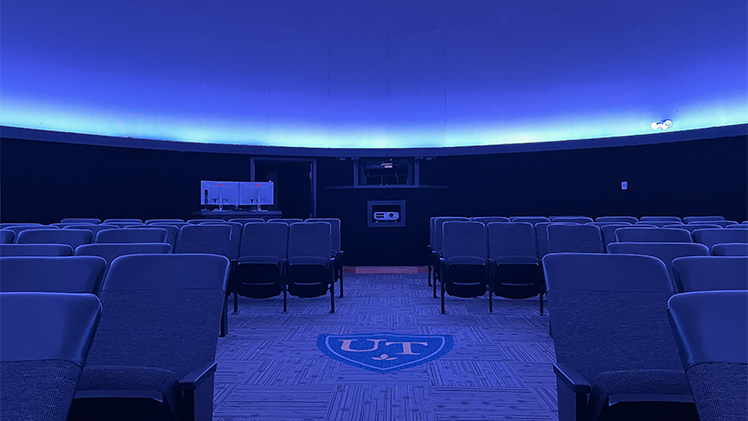Look to the northwest skies over Toledo just after sunset and you’ll see a ball of white light second only to the moon as the brightest object in the sky. What appears to be a star, though, is Earth’s closest planetary neighbor, Venus.
UToledo’s Ritter Planetarium will offer an in-depth exploration of the night sky this time of year in its monthlong program “Summer Skies Over Toledo.” Scheduled at 8:30 p.m. each Friday in July, “Summer Skies Over Toledo” is a live star talk on what’s above us in northwest Ohio – the constellations, planets and deep space objects — and how this region of the sky helps astronomers understand our universe.

Ritter Planetarium was recently upgraded with a $320,000 digital projection system that provides better quality imagery at 4K and the ability to bring livestreamed events and shows to the 40-foot domed ceiling.
“We do a short live star talk at the beginning of all of our shows,” said Dr. Michael Cushing, a professor of physics and astronomy and director of Ritter Planetarium. “But the ‘Summer Skies Over Toledo’ goes deeper than that” as a full show devoted to backyard astronomy.
For example, the constellation Sagittarius is visible over Toledo right now. But what is not visible is the supermassive black hole in Sagittarius that is at the heart of our galaxy.
Presented by Heidi Westrick, Ritter Planetarium assistant director and UToledo alumna, the program is a suggestion to all of us buried in our phones and screens to look up at the universe’s grand wonders.
“We have a natural affinity to look at the sky,” Cushing said, “the sky is a beautiful place. There are all sorts of things to see if people would just look up once and a while to see them.”
In August, Ritter Planetarium will feature another program each Friday at 8:30 p.m., “Cosmic Colors,” which answers questions like, why is the sky blue and why are plants green. “Cosmic Colors” will also go beyond the visible spectrum and explore the rest of the electromagnetic spectrum including radio waves, infrared, ultraviolet, X-rays and gamma rays.
“It’s all about the electromagnetic spectrum and how it helps us understand the universe,” Cushing said. “Most people are familiar with the visible light, and everyone’s heard of X-rays and gamma rays, which are all just different forms of light.
The discovery of these forms of light in the mid-20th century “changes our perspective,” he said. A similar shift in our perspective occurred with the discovery of gravitational waves in 2016.
“Gravitational waves had been predicted for nearly a century, but being able to finally detect them provided a new way of looking at the universe. Now we detect neutron stars colliding and making black holes or two black holes converging. It’s opened a new window into the universe.”
In addition to the new summer programming, the Ritter Planetarium was recently upgraded with a $320,000 digital projection system. The Digistar 7 is a state-of-the-art projection system that provides better quality imagery at 4K and the ability to bring livestreamed events and shows from around the world to the 40-foot domed ceiling.
The Digistar 7 system replaces the SciDome XD projector system acquired in 2011. The renovations were made possible by the generosity of a loyal donor.
“We can now fly through the rings of Saturn and see the chunks of ice and rocks and then fly to planets more easily,” Cushing said. “These were possible with the old system, but we rarely did it because it was clunky and didn’t really look good. Now it’s just seamless.
“The experience is just much clearer now,” he added. “It’s subtle but to us, it’s a game-changer, the ability to interact with the audience and respond to their questions in near real-time.”
Admission to the Ritter Planetarium programs is $8 for adults and $6 for children, senior citizens and UToledo community members. Doors will open 30 minutes prior to the show.
The planetarium portion of the program lasts approximately one hour, consisting of both the show and a Q&A session. Weather permitting, the evening shows will be followed by observing at Brooks Observatory atop McMaster Hall to view the stars and planets through UToledo’s Celestron 14 Edge HD telescope.
The planetarium hosts more than 300 programs each year, and approximately 5,000 students visit the planetarium annually.
For more information about the summer programs, visit the Ritter Planetarium website.